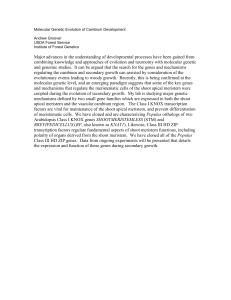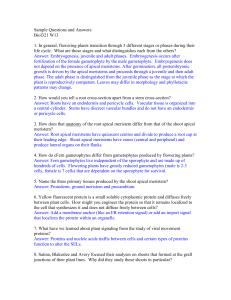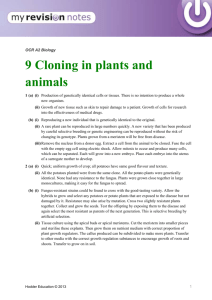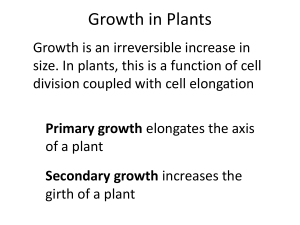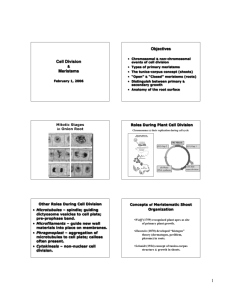Experimental Anatomy of Plant Development Laboratory 3
advertisement
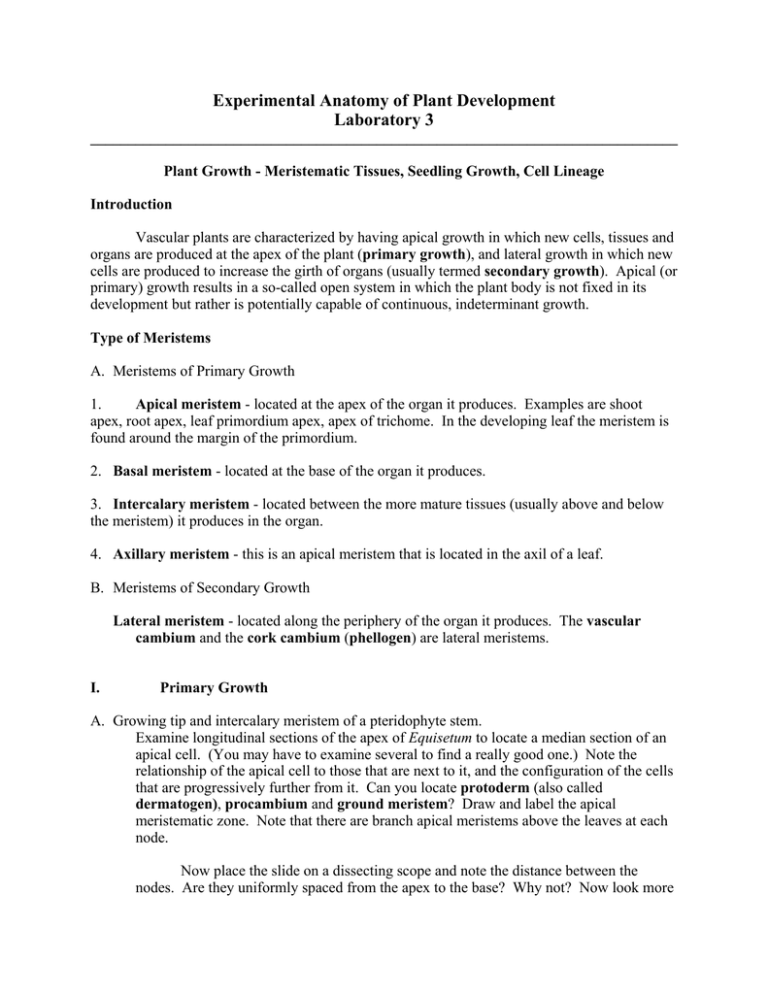
Experimental Anatomy of Plant Development Laboratory 3 ______________________________________________________________________________ Plant Growth - Meristematic Tissues, Seedling Growth, Cell Lineage Introduction Vascular plants are characterized by having apical growth in which new cells, tissues and organs are produced at the apex of the plant (primary growth), and lateral growth in which new cells are produced to increase the girth of organs (usually termed secondary growth). Apical (or primary) growth results in a so-called open system in which the plant body is not fixed in its development but rather is potentially capable of continuous, indeterminant growth. Type of Meristems A. Meristems of Primary Growth 1. Apical meristem - located at the apex of the organ it produces. Examples are shoot apex, root apex, leaf primordium apex, apex of trichome. In the developing leaf the meristem is found around the margin of the primordium. 2. Basal meristem - located at the base of the organ it produces. 3. Intercalary meristem - located between the more mature tissues (usually above and below the meristem) it produces in the organ. 4. Axillary meristem - this is an apical meristem that is located in the axil of a leaf. B. Meristems of Secondary Growth Lateral meristem - located along the periphery of the organ it produces. The vascular cambium and the cork cambium (phellogen) are lateral meristems. I. Primary Growth A. Growing tip and intercalary meristem of a pteridophyte stem. Examine longitudinal sections of the apex of Equisetum to locate a median section of an apical cell. (You may have to examine several to find a really good one.) Note the relationship of the apical cell to those that are next to it, and the configuration of the cells that are progressively further from it. Can you locate protoderm (also called dermatogen), procambium and ground meristem? Draw and label the apical meristematic zone. Note that there are branch apical meristems above the leaves at each node. Now place the slide on a dissecting scope and note the distance between the nodes. Are they uniformly spaced from the apex to the base? Why not? Now look more closely at the cells just above the basal-most node, and locate the intercalary meristem. Look for the intercalary meristems at the other nodes. Now you should know why the spacing of the nodes is not uniform. Draw the intercalary meristem of one node. B. Growing tip of a seed-plant stem (the shoot apical meristem (SAM)) Examine a longitudinal section of the growing tip of a stem of Coleus. Locate the apical meristem at the very apex of the stem. Note the nature of the meristematic cells in and below the apical dome. Draw and label the tunica and corpus (central mother cells), the peripheral zone (flank meristem), and the pith or rib meristem. You will also find leaf primordia, immature leaves, whose initial cells have been produced at the growing point. As you move back from the apex of the stem, you will begin to see various changes in the cells, as they mature or differentiate. Can you identify a level where there is procambium, but no differentiated tracheary elements? The activity at this growing tip and the subsequent differentiation will result in the kind of primary structure you saw in an earlier laboratory when you examined a cross section a stem with a mature primary body. C. The root apical meristem (RAM) Now examine a slide of Allium (onion) or Vicia (bean) that shows the apical meristem of the root in longitudinal section. Diagram and label the meristem. Be sure to include the promeristem, protoderm, procambium and ground meristem. Can you detect a quiescent zone in the promeristem of this root? Why or why not? How is the root cap produced? Where are the root cap columella cells? If this were the root of a pteridophyte, would you see the same organization of the meristem? What would you expect to see? II. Elongation and Differentiation Once cell division has occurred in the meristem, the next step to growth is cell elongation. Cell elongation requires 1) cell wall loosening, 2) an increase in solutes resulting in water uptake and 3) re-synthesis of cell wall polymers. Once a cell has reached its final size, cell differentiation is the next step in growth. Although each cell proceeds through these stages of growth over time, regions of the growing shoot or root can be identified with each stage of growth. In a growing shoot or root, the region just basal to the meristem is considered the region of elongation. This area can be easily identified by the elongated, rectangular shape of the cells. The region of differentiation (or maturation) can be easily identified by the deposition of lignin, waxes etc and is basal to the region of elongation. In roots, the region of maturation is the region where root hairs can first be seen. These regions should be easy to identify in the sections you previously made for the SAM and RAM. Mini Project 1. Meristematic Activity - Immunolocalization of PCNA PCNA, proliferating cell nuclear antigen, is required for DNA replication. The gene is highly conserved in plants and animals and antibodies against human PCNA cross-react with a single band in western blots of plants meristematic tissue. Studies have shown the PCNA is regulated by the cell cycle in both plants and animals. You will compare meristem structure in monocots and dicots using PCNA as a marker for S phase. Today you will fix tissues from corn and bean. You should fix both roots and shoot apical meristems. For your lab notebook, longitudinal sections of four apices are required. Corn SAM, Corn RAM, Bean SAM, Bean RAM At least one control for each section should also be included. The control for background staining is to omit the primary antibody, so that non-specific binding of the secondary antibody can be detected. For each SAM, label the tunica and corpus and leaf primordium. For each RAM, label the root cap columella cells, quiescent center, and stele, ground tissue, and epidermis. Briefly (one paragraph) described the results of your immunolocalization exercise. Describe background staining. Comment on the pattern of PCNA expression. Was it uniform throughout the meristem? If not, it may reflect S phase activity. Is there a pattern to cells in S phase?

